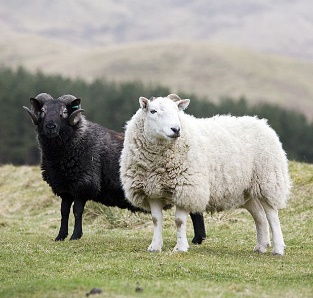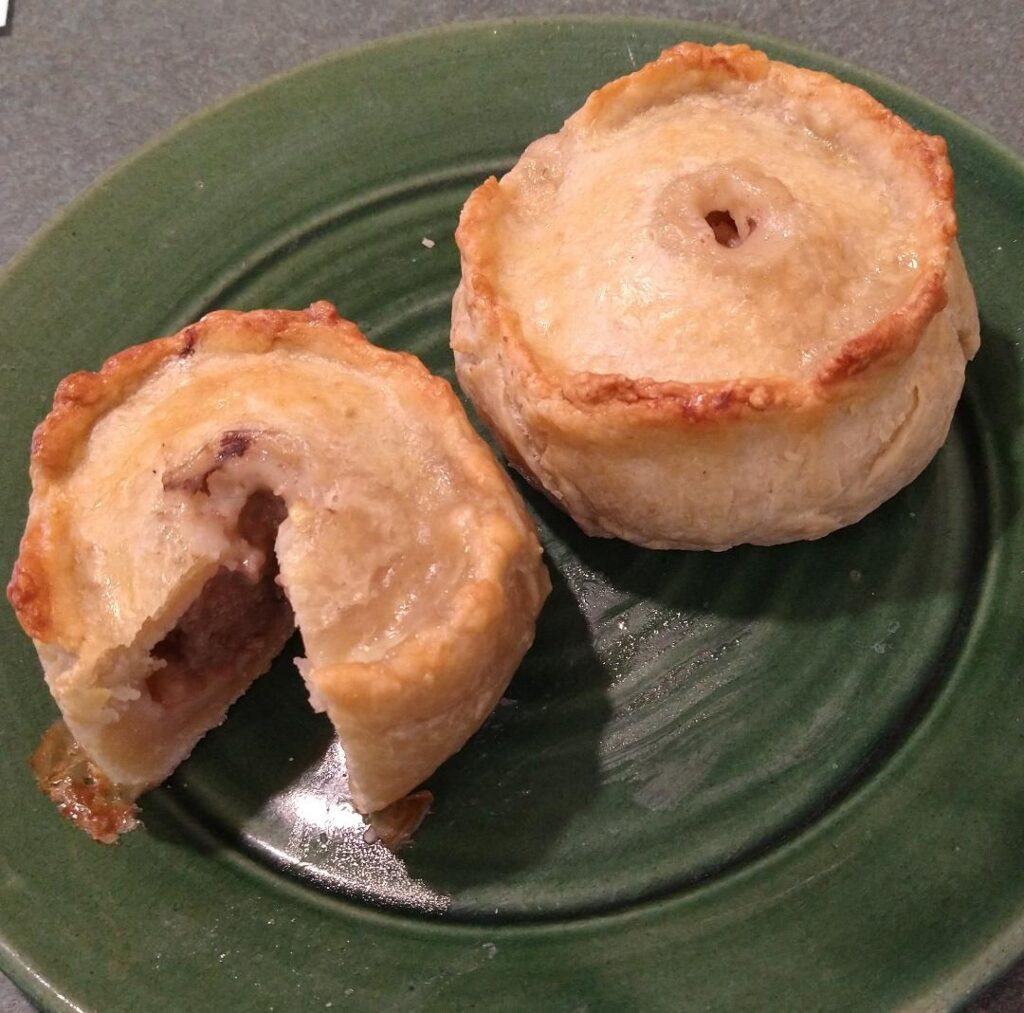Carolyn McDonald Graf
This article on Sheep in Scotland is so interesting and well written that I have included it in its entirety. A recipe for Scotch Pie follows.

You won’t travel far in Scotland without seeing them. On fields of green and hills of heather, in fenced, stone-dyked and hedged enclosures, up in the Highlands, across the Borders, on islands, in glens, on muirs, even beaches, and on single-track roads. The Scottish landscape is specked with the white-ish presence of some six and three quarter million sheep.
These woolly inhabitants are far more than the providers of that leg of lamb studded with garlic and rosemary for Sunday’s roast. Sheep have been at the heart of historic political conflict as well as great movements of the Scottish population, they’ve led the world in cutting-edge DNA engineering, and daily touch the lives of close to 10,000 producers, processors and others whose livelihoods depend on them.
This gentle beast provides the ingredients for at least two of Scotland’s iconic national dishes, as well as regional dishes that still connect us to the early days of rural living and traditional food culture.
Today, the reality of modern sheep farming is less about the romantic image of a shaggy-coated animal standing on a misty hillside and more about the unrelenting commercial pressures of modern consumers and retailers, who demand a uniform product that’s less fatty but still meaty.
It’s a very long way from the primitive, long-haired breed first domesticated perhaps as far back as 4000BC. The Romans, the Danes and twelfth-century monks all then had a subsequent influence on a Scottish lineage that produced both wool and meat, and some milk too.
In the late eighteenth century, as the French Revolution blazed, sheep were the spark that ignited the most incendiary issue of Scottish land ownership. As the feudal masters of the Highlands saw the commercial possibilities of large-scale sheep farming, it was the tenants on their lands that had to move on to make space for big flocks.
These ‘clearances’ threw the local population out to endure a precarious living on the coast, or to lowland towns and cities soon to be industrialized, or further still, across the ocean to Canada and the USA.
For any explanation of sheep as farm animals and, ultimately, food, a few definitions are in order. What is lamb, for instance? And what makes it Scottish? The latter is easy; the former can get a bit complicated.
To be ‘Scotch’ lamb, it has to be born, raised, finished and slaughtered in Scotland. Every animal receives a unique number that is the indicator of its movement through to slaughter, carrying information regarding its origin, ownership, health record and so on.
To be sold as lamb, the animal should be under a year old. Classically, ‘new season’ lamb would be born very early in the spring and come to market in late summer. Buy it any earlier in the year and you’re either getting ‘old season’ lamb, born the previous year, or an animal that arrived in the midst of winter and was raised indoors.
Breeds and seasons
So, whatever its age, what actually is this lamb you’ll be eating? The most numerous breed in Scotland is the ‘Blackie’, or black-faced sheep. This hill-breed can live well in the difficult conditions of Scotland. But the lamb that comes to table in most numbers is a cross breed, crossed at least twice with breeds that offer bigger frames, more muscles and lighter bones. Not forgetting better mothering and faster growing qualities. The result is your modern roast lamb with plenty of muscle but not too much fat.
The slaughtered lamb goes to a cutting plant or to individual butchers to be butchered into the cuts that find their way into supermarket chiller cabinets or high-street butcher counters.
Only a very few flocks are kept in Scotland for milk, though some of the country’s most highly thought of cheeses are made with ewe’s milk.
Of course, there are some alternatives to the industrial food chain, where provenance isn’t lost after the final sale. Some sheep farmers and crofters have taken a more direct route to the market, raising (and in certain rare cases, slaughtering) then butchering their own animals, on a small scale, to be sold online, at farmers’ markets or farm shops. Their efforts to offer complete traceability, fewer food miles and improved animal welfare has increasingly found favor with consumers concerned that their food has been produced to the highest ethical standards.
Besides lamb, these smaller enterprises have been reviving the public’s taste for mutton, still suffering from an out-dated perception of being tough and ‘gamey’.
It was never quite thus. In the days when sheep were kept for wool, there were many more older animals as a result, and eating them seemed pretty natural. But as wool prices declined and frozen Australian lamb arrived, mutton soon left Scotland’s household menu.
Not in the Shetland Islands, however. There, Reestit Mutton lives on. It’s a cured dish made from a variety of cuts, salted and then dried hanging from a rafter (reestit) in a croft over an open peat fire. Whilst the exact technology of preservation has moved on, you can still sample this traditional delicacy at the Up-Helly-Aa celebrations in January.
Shetland is also home to one of the rarer, more traditional sheep breeds you will find in Scotland. The Shetland sheep is a small-boned creature with fine wool and a range of colors valued by knitters of Fair Isle jumpers, and flesh flavored by grazing wild on the natural plant life of the islands. That unique identity has been recognized by its PDO status (1).
This brings us to the iconic national dish that has Scottish sheep at its heart. Haggis, ‘sheep’s pluck in a sheep’s stomach’, is the subject of poetry, myth and ceremony. Whilst not always containing sheep’s liver, heart and lungs in the early days (some calf and pork innards were involved) and with its origins more likely to be south of the border, it’s a dish that blends frugality, national identity and a hearty dish all in one recipe.
Out on the football terraces, or at a lunch break, there’s another typical Scottish dish that owes its filling to the ubiquitous denizen of the Scottish hills and glens. A Scotch pie has a hot-water pastry casing, made with beef dripping (not pig fat as in England), traditionally filled with minced mutton.
Lamb or mutton, however you slice it, or eat it – in a pie, on a sandwich, for a Sunday roast or summer BBQ, on Burns’ Night or a pub night, it’s a food that dominates the Scots culinary landscape, much as it does its physical scenery.
(1) “PDO” stands for “Protected Designation of Origin”
https://food.list.co.uk/article/54361-scotlands-food-landscape-sheep/
Scotch Pie

Meat Filling Ingredients:
- 1 lb lean lamb (or ground beef), minced
- pinch (1/4 tsp) of mace or nutmeg
- 2 tsp Worcestershire sauce
- 1/4 tsp salt and 1/4 tsp pepper
- 1/4 pint gravy (see below)
Gravy Ingredients: (this makes 2 cups of gravy which allows for extra if you want to put it over the finished pies)
- 2 tbsp butter
- 2 tbsp olive oil (or bacon fat)
- 1/4 cup flour
- 2 cups beef broth
Hot Water Pastry Ingredients:
- 4 cups plain flour
- 3/4 cup lard (if no lard available, use 1/4 cup butter and 1/2 cup Crisco)
- 3/4 cup water
- pinch of salt
- milk or egg mixed with water for glazing
Directions:
- Preheat oven to 350 F
- Meat Filling: In a medium bowl, mix together the ground meat, nutmeg, Worcestershire, salt, and pepper. Set aside.
- Gravy: In a medium saucepan, melt 2 tbsp butter and 2 tbsp oil over medium heat. Add flour and cook, stirring constantly, for 30 sec. Slowly whisk in beef broth making sure no lumps form. Cook until thickened and then set aside.
- Pastry: In a large warm bowl, sift together the flour and salt. Make a well in the center of the flour. Melt the lard in 3/4 cup of water and, when it is boiling, add to the flour and mix thoroughly. Knead for about 3-5 mins. This makes a soft pastry the consistency of Play Doh. Use it quickly and keep un-used portions covered and warm as it will harden as it cools. This makes a very firm pastry that is crispy on the outside but soft on the inside.
- Pies: Take a small amount of dough and form into a ball keeping the rest warm while making each pastry. Roll out the dough and shape the crust around the base of a glass or a mold (about 3-3 1/2 in. diameter) making sure there are no cracks in the pastry. As the pastry cools, remove from the mold. Continue making pies until you have 1/4 the pastry left for lids. Divide the meat between the 8-10 shells you made and add a tbsp of gravy to moisten the meat. Roll out the remaining pastry and use 3-1/2 to 4 in round cookie cutter to cut out the lids. Use a round cutter for the lids or maybe a 1 cup measuring cup. Wet the edge of the lids and the inside lip of shell. Place the lids over the meat and press down lightly over the filling. Pinch the edges together to form a seal. Glaze lids with milk or egg-wash using a pastry brush. Cut a small hole or vent in the center of the lid to allow steam to escape.
- Bake 45 mins. at 350 F. Serve with additional gravy if desired. If the pies are not eaten immediately, they can be stored in the fridge, but always ensure they are properly reheated before being consumed.
Serves: 8-10

